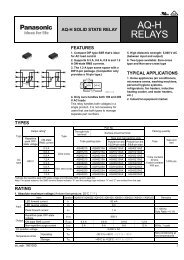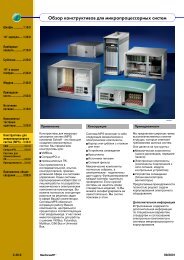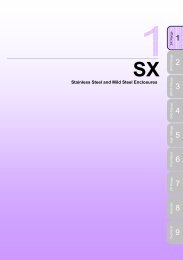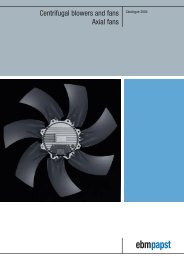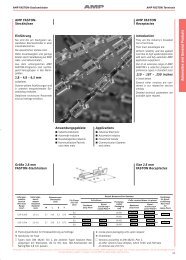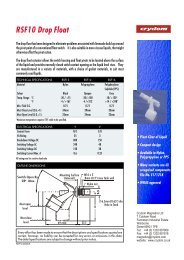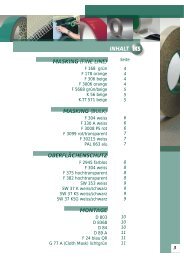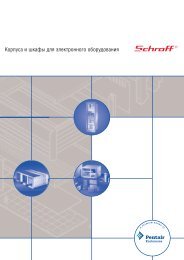Snap-Action Switches Detection Switches General Catalogue 2005
Snap-Action Switches Detection Switches General Catalogue 2005
Snap-Action Switches Detection Switches General Catalogue 2005
Create successful ePaper yourself
Turn your PDF publications into a flip-book with our unique Google optimized e-Paper software.
TECHNICAL TERMINOLOGY & CAUTIONS FOR USE<br />
TECHNICAL TERMINOLOGY & CAUTIONS FOR USE<br />
TECHNICAL TERMINOLOGY<br />
1. Rated values<br />
Values indicating the characteristics and<br />
performance guarantee standards of the<br />
snap-action switches. The rated current<br />
and rated voltage, for instance, assume<br />
specific conditions (type of load, current,<br />
voltage, frequency, etc.).<br />
2. Mechanical life<br />
The service life when operated at a<br />
preset operating frequency without<br />
passing electricity through the contacts.<br />
(The life test is performed at a switching<br />
frequency of 60 times/minute and<br />
operating speed of 100 mm/second at the<br />
regular cam.)<br />
3. Electrical life<br />
The service life when the rated load is<br />
connected to the contact and switching<br />
operations are performed. (The life test is<br />
performed at a switching frequency of 20<br />
times/minute and operating speed of 100<br />
mm/second at the regular cam.)<br />
4. Contact form<br />
This refers to the components<br />
determining the type of application which<br />
make up the electrical input/output<br />
circuits in the contact.<br />
Switching<br />
type<br />
Normally<br />
closed type<br />
Normally<br />
open type<br />
COM<br />
COM<br />
COM<br />
Terminal symbols<br />
COM: Common terminal<br />
NC: Normally closed terminal<br />
NO: Normally open terminal<br />
5. Insulation resistance<br />
Resistance between noncontinuous<br />
terminals, terminals and metal parts not<br />
carrying current, and between terminals<br />
NC<br />
NO<br />
NC<br />
NO<br />
and the ground.<br />
6. Withstand voltage<br />
Threshold limit value that a high voltage<br />
can be applied to a predetermined<br />
measuring location for one minute<br />
without causing damage to the insulation.<br />
7. Contact resistance<br />
This indicates the electrical resistance at<br />
the contact part. <strong>General</strong>ly, this<br />
resistance includes the conductor<br />
resistance of the spring and terminal<br />
portions.<br />
8. Vibration resistance<br />
Malfunction vibration ... Vibration range<br />
where a closed contact does not open for<br />
longer than a specified time due to<br />
vibrations during use of the snap-action<br />
switches.<br />
9. Shock resistance<br />
Shock durability ... Shock range where<br />
the mechanical shocks received during<br />
snap-action switches transport and<br />
installation do not damage the parts or<br />
harm the operating characteristics.<br />
Malfunction shock ... Shock range where<br />
a closed contact does not open for longer<br />
than a specified time due to shocks<br />
during use of the snap-action switches.<br />
10. Operating Force (O.F.)<br />
The force required to cause contact<br />
snap-action. It is expressed terms of<br />
force applied to the plunger or the<br />
actuator.<br />
11. Release Force (R.F.)<br />
The force to be applied to the plunger or<br />
the actuator at the moment contact snaps<br />
back from operated position to<br />
unoperated position.<br />
12. Pretravel (P.T.)<br />
Distance of the plunger or the actuator<br />
movement from free position to operating<br />
position.<br />
13. Overtravel (O.T.)<br />
The distance which the plunger or the<br />
actuator is permitted to travel after<br />
actuation without any damage to the<br />
switching mechanism.<br />
14. Movement Differential (M.D.)<br />
The distance from operating to release<br />
position of the plunger or the actuator.<br />
15. Operating Position (O.P.)<br />
The position of the plunger or the<br />
actuator when the traveling contacts<br />
snaps with the fixed contact.<br />
16. Free Position (F.P.)<br />
Position of the switch plunger or the<br />
actuator when no force is applied to.<br />
17. Overtravel Position (O.T.P.)<br />
The stopping position of the plunger or<br />
the actuator after total travel.<br />
18. Release Position (R.P.)<br />
The position of the plunger or the<br />
actuator when the traveling contact snaps<br />
back from operating position to its original<br />
position.<br />
The following terminologies are applied to<br />
all our switches.<br />
F.P.<br />
P.T.<br />
O.P.<br />
O.F.<br />
O.T.<br />
T T.P.<br />
T.F.<br />
M.D.<br />
R.P.<br />
R.F.<br />
Center of mounting holes<br />
T.T.<br />
CAUTIONS FOR USE<br />
■ Technical Notes on Mechanical Characteristics<br />
1. Actuation Force and Stroke<br />
may cause actuator damage due to<br />
Adequate stroke setting is the key to high inertia of the drive mechanism. It is<br />
reliability. It is also important that<br />
advisable that the stroke be adjusted with<br />
adequate contact force be ’maintained to the mounting plate or driving mechanism.<br />
ensure high reliability. For a normally The figure at right shows a typical<br />
closed circuit, the driving mechanism example of activation and contact forces<br />
should be set so that the actuator is varying with stroke. In the vicinity of the<br />
normally in the free position. For a<br />
O.P. and R.P., the contact force is<br />
normally open circuit, the actuator should diminished, causing chatter and contact<br />
be pressed to 70% to 100% of the<br />
bounce immediately before or after<br />
specified stroke to absorb possible reversal. For this reason, use the switch<br />
errors.<br />
while giving due consideration to this.<br />
If the stroke is set too close to the<br />
This also causes the snap action switch<br />
operating point (O.P.), this may cause to be sensitive to vibration or physical<br />
unstable contact, and in the worst case impact.<br />
10<br />
Contact force Operating force<br />
OF<br />
RF<br />
NC<br />
On FP<br />
On reversal<br />
On reversal<br />
On OTP<br />
NO<br />
FP RP OP TTP<br />
PT MD OT<br />
Stroke<br />
Stroke




